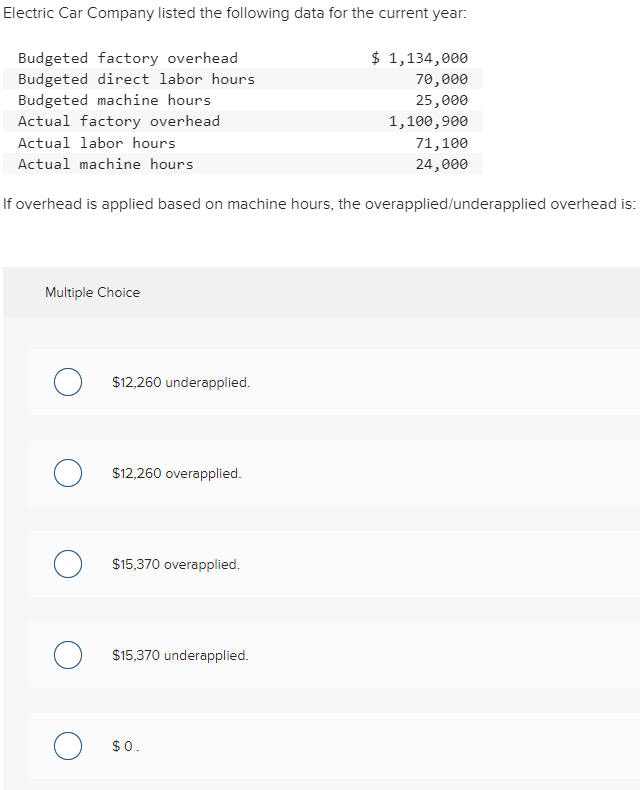Overapplied Overhead Definition

One strategy is to refine the predetermined overhead rate by using more accurate and dynamic allocation bases. For example, activity-based costing (ABC) can provide a more precise method of allocating overhead by linking costs to specific activities and cost drivers. This approach helps in identifying inefficiencies and areas for cost reduction, ultimately leading to more accurate overhead allocation.
6: Determine and Dispose of Underapplied or Overapplied Overhead
- Once the period concludes, actual overhead costs and actual activity levels are recorded.
- Now the machine shop has to book an additional $600 of overhead expense because the original estimate what under applied.
- Most managers want to be able to show a profit even after overhead expense, so an estimated amount of overhead is applied for each period.
- One strategy is to refine the predetermined overhead rate by using more accurate and dynamic allocation bases.
- The next step involves comparing the allocated overhead, calculated using the predetermined rate, to the actual overhead incurred.
- After this journal entry, the balance of manufacturing overhead will become zero.
In a sense, the production managers came in “under budget” and achieved a lower overhead than the cost accountants estimated. In this case, XYZ Corp. will need to make an adjustment to its accounting records to account for the overapplied overhead. This could involve decreasing the cost of goods sold, or adjusting other inventory accounts depending on the company’s accounting policy. This will ensure the company’s financial statements accurately reflect the actual overhead costs incurred during the period.
Products
These may be explained by expected hiccups in production, business, or seasonal variation. It is useful to note that some companies may use the more accurate method, but more time-consuming, to reconcile the underapplied or overapplied overhead. That method will not only allocate the overhead to the cost of goods sold but also to the work in process inventory account and the finished goods inventory account. Effective management of overapplied overhead requires a combination of proactive planning and continuous monitoring.

Overapplied Overhead
In this book, we assume companies transferoverhead balances to Cost of Goods Sold. We leave the morecomplicated procedure of allocating overhead balances to inventoryaccounts to textbooks on cost accounting. If not adjusted, the overapplied amount can lead to an overstatement of net income. This can have tax implications, as higher reported earnings may result in a larger tax liability. Additionally, it can affect dividend distributions, as companies might distribute more profits than they actually earned, potentially straining cash flows. Since we will be using the concept of thepredetermined overhead rate many times during the semester, letsreview what it means again.
What is Overapplied Overhead?
This will result in an excess charge of $15,000 to the cost of goods sold, if the situation is not corrected. To do so, the company’s controller debits the manufacturing overhead cost pool for $15,000, while crediting the cost of goods sold account for the same amount. The result is a cost of goods sold that incorporates only the actual overhead costs incurred during the month of March.
Overapplied overhead, on the other hand, occurs when a company has overhead costs less than its budgeted costs. To determine applied overhead, the company needs to know its budgeted overhead and actual overhead. Companies use overhead analysis 9 states with no income tax to determine their efficiency during a period of controlling overhead costs. Overapplied overhead occurs when the total amount of factory overhead costs assigned to produced units is more than was actually incurred in the period.
These entries ensure that the financial statements accurately reflect the company’s actual costs and financial position. The process begins by identifying the amount of overapplied overhead, which is the difference between the allocated overhead and the actual overhead incurred. Once this amount is determined, it must be removed from the accounts where it was initially applied.
McBride is an attorney with a Juris Doctor from Case Western Reserve University and a Master of Science in accounting from the University of Connecticut. Textbook content produced by OpenStax is licensed under a Creative Commons Attribution-NonCommercial-ShareAlike License .
To determine overapplied overhead, one must first understand the components involved in overhead allocation. Overhead costs include indirect expenses such as utilities, depreciation, and maintenance, which are not directly traceable to specific products. These costs are allocated to products using a predetermined overhead rate, often based on direct labor hours, machine hours, or another activity driver. This rate is established at the beginning of the accounting period based on estimated overhead costs and estimated activity levels. Sometimes the estimate is more than the actual amount and sometimes it’s less than the actual amount. Overapplied overhead happens when the estimated overhead that was allocated to jobs during the period is actually more than the actual overhead costs that were incurred during the production process.

